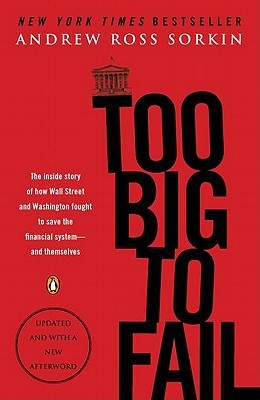Title: Too Big to Fail: The Inside Story of How Wall Street and Washington Fought to Save the Financial System –and Themselves
Author: Andrew Ross Sorkin
Publisher: Penguin
ISBN: 9780143118244
Pages: 640, Paperback/Hardcover/Kindle/Audio/CD
Genre: Business/Economic History
Reviewed by: Dr. Joseph S. Maresca, Pacific Book Review
Book Review
This is an excellent rendition on the details of the 2008 stock market crash. The author relates a very complicated story of a series of financial mishaps with many pictures around the center of the book. Dick Fuld, CEO of Lehman Brothers is pictured during a confrontation with an angry mob. He stated “This is a pain that will stay with me the rest of my life.”In 2007, financial services grew to over 40% of the total corporate profit. The new Citigroup reported a disappointing 3rd quarter which resulted from turmoil involving a Russian default and a hedge fund LT Capital Management which nearly toppled.
The author relates how Mr. Bernanke- the current Fed Chair believed in the economics of Milton Friedman and Anna Schwartz. Anna was a monetary historian of the USA for the period 1867- 1960. She believed that the Federal Reserve of the period precipitated the Great Depression by not immediately flushing the system with cheap cash to stimulate the economy. Her theory has some foundation; however, the reckless stock market behavior of the roaring 20s was a significant contributing factor for sure.
Various economists have developed impressions of the post-Depression recovery over the years. Some believe that WW2 fueled the recovery. Others believe that the USA consumers simply spent our way out of the Depression at some point. I believe that monies expended on wars could be better spent on Civil Engineering projects to upgrade infrastructure.
WW2 wasn’t avoidable; however, there are questions about the necessity of the subsequent Vietnam, Iraq II and Afghanistan Wars. The USA is sitting on a 400 year supply of coal, a 1000 year supply of natural gas, ample wind energy technologies and locations, solar energy and the emergent “Artificial Sun” virtual power project.
Saturn’s orange moon Titan has hundreds of times more liquid hydrocarbons than all the known oil and natural gas reserves on Earth. (NASA’s Cassini spacecraft) The hydrocarbons literally rain from the sky. Vast deposits are collected in lakes and dune formations. Practically speaking, commercialization is decades away. Nonetheless, Saturn’s Titan has the potential to become a permanent game changer later this century and permanently thereafter.
“Titan is just covered in carbon-bearing material, it’s a giant factory of organic chemicals,” says Ralph Lorenz, Cassini radar team member from the Johns Hopkins University Applied Physics Laboratory. “This vast carbon inventory is an important window into the geology and climate history of Titan.”
In May 2008, AIG reported a 9 billion dollar write down on credit derivatives and a 7.8 billion dollar loss. Later that year, Warren Buffet explained that he got out of a derivative instrument investment(s) which cost 400 million dollars to exit.
For sure, the markets would benefit from a thorough review of derivatives and possibly an update of the Uniform Commercial Code to set forth the rights, duties and obligations of the various parties and counterparties. I don’t understand why there are numerous definitions for commercial paper in the UCC and virtually nothing set forth for derivatives.
AIG- CEO Williamstad explained that there was a problem if AIG counter parties decided ( on a collective basis) to demand cash immediately. Surprisingly, AIG had $78 billion dollars more in assets than liabilities. Nonetheless, the assets were held by 71 state regulated insurance subsidiaries.
The 4th Quarter of 2003 OCC report documents 7 banks with the most derivatives which comprise over 96% of the total derivatives in 573 commercial banks with derivatives. These derivatives are in futures, swaps, options and credit derivatives. Source Graph 4; P. 9.
The derivatives (notionals) by the type of user grew from $8 trillion dollars in 1990 to over $70 trillion dollars by 2003. (Mostly dealer notionals) Source: P. 6 of 27.
The change in the notional volume reflects business activity and not risks per se. ” 7 commercial banks account for 96% of the total notional amount of derivatives in the commercial banking system with 99% held by the top 25 banks”. Table 3,5 and Graph 4
Risks are a function of the following items: (Source: OCC 4th Quarter Report ’03)
* Counterparty exchange of nominal principal.
* Volatility of interest rates and currencies used to determine the contract payments.
* The maturity and liquidity of contracts.
* Creditworthiness of counterparties in the transaction.
The degree of risk is a function of:
* Aggregate trading positions.
* Asset and liability structures.
* Data describing fair values and credit risk exposure is more useful for point in time risk exposure.
* Data on trading revenues and contractual maturities.
On 9-19-08, Secy Paulson announced the creation of a Troubled Asset Relief Program; wherein, a series of grants and outright purchases of illiquid assets would extricate the problem areas weighing down the economy. In addition, money funds were to be guaranteed. There was an underlying weakness with regard to illiquid mortgages losing value in a significant housing correction. Illiquid assets are known to choke off the flow of credit.
Generally, I know that real estate recessions can last 4 years or more. A turnaround will come for certain due to the ever growing demand for real estate. In 1960, there were 180MM people in the USA as opposed to 300MM today and a 1/2 billion by 2050 (projections).
With those numbers, there will be a turnaround in the real estate markets for sure. In addition, real estate recessions do not always impact the entire country. Location has always been the rule in real estate. Properties in prime locations will hold their value in virtually any real estate market.
Overall, the book is an excellent value for the reasonable price charged. I would read this book thoroughly before investing another penny in the stock market!


